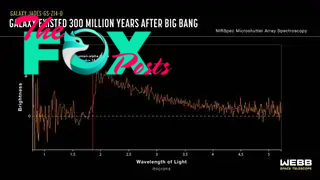Science
Can the James Webb Space Telescope see galaxies over the universe's horizon?
Since it began sending data back to Earth in 2022, the James Webb Space Telescope (JWST) has greatly impacted astronomy, and one of its most revolutionary achievements is the observation of some of the most distant galaxies ever seen. However, because light doesn't travel instantly — but rather moves at about 300 million meters (985 million feet) per second in a vacuum — we don't see those galaxies as they are today, but as they were billions of years ago.
Moreover, our universe is estimated to be 13.8 billion years old. So, we should assume that the most distant galaxy we could ever hope to see is no more than 13.8 billion light-years away. (One light-years is the distance light travels in a year). That point should be a "cosmological horizon" of sorts — beyond which no telescope should be able to see. And, because nothing can travel through space faster than c, that means there should be no way a galaxy further than 13.8 billion light years away, and getting more distant all the time could affect Earth. Right?
Wrong. If only the universe were that simple.
"A cosmological horizon is a maximum distance from which one could possibly retrieve information," Jake Helton, a University of Arizona astronomer who is also part of the JWST Advanced Deep Extragalactic Survey (JADES) team, told Space.com.
"There are a few different cosmological horizons," Helton continued, "which have different definitions and depend on various cosmological quantities. The most relevant here is the cosmological horizon which is the maximum distance from which light could have Traveled to us in the age of the universe. This defines the edge of the observable cosmos."
Related: 'The early universe is nothing like we expected': James Webb telescope reveals 'new understanding' of how galaxies formed at cosmic dawn

In March of 2024, JADES scientists revealed the powerful telescope had spotted JADES-GS-z14-0, the most distant and early galaxy humanity has ever seen. The paradox, however, is that JADES-GS-z14-0 is located about 33.8 billion light years away.
-

 Science2d ago
Science2d agoInside Capitol Hill’s Latest UFO Hearings
-

 Science2d ago
Science2d agoYou Won’t Want to Miss the Leonid Meteor Shower. Here’s How and When You Can See It
-

 Science2d ago
Science2d agoHere’s What Trump’s Win Means for NASA
-

 Science6d ago
Science6d agoWhy Risky Wildfire Zones Have Been Increasing Around the World
-

 Science6d ago
Science6d agoIt’s Time to Redefine What a Megafire Is in the Climate Change Era
-

 Science1w ago
Science1w ago4 Astronauts Return to Earth After Being Delayed by Boeing’s Capsule Trouble and Hurricane Milton
-

 Science1w ago
Science1w agoThe Elegance and Awkwardness of NASA’s New Moon Suit, Designed by Axiom and Prada
-

 Science1w ago
Science1w agoSpaceX Launches Its Mega Starship Rocket. This Time, Mechanical Arms Catch It at Landing


























